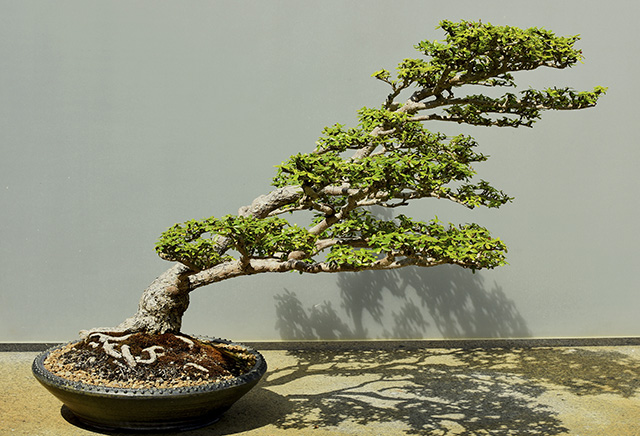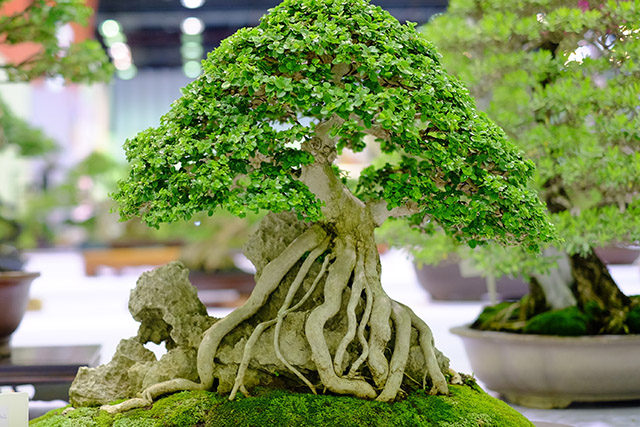
Bonsai is the epitome of beautiful scenery and art to express magnificent nature through potted trees. Imitating nature in its finest forms, creating bonsai is limitless and is open to personal interpretation and creativity. Needless to say, knowing the basic styles is important to gain a basic understanding of their beauty. Here is a guideline to help you get familiar with bonsai.
-
01
Difference Between Bonsai & Potted Plant
Bonsai are required to plant trees in pots and tailor them beautifully to express the natural landscape. If a tree is just planted in a pot, it is a potted plant but a bonsai is a work of art that can be modified and shaped to recreate a natural scene in a small pot. Some branches are covered with wire to shape the tree in anyways but must reflect the forms seen in nature. For example, to express the trees with the wind blowing at the very moment, the main branch stays in position. Meanwhile, thin branches and leaves from which the wind is blowing are swept away. And the ones in the opposite direction stay. This type of bonsai is known as “Fukinagashi” literally translated as windswept style. Likewise, there are many other basic styles to each bonsai.
![Making windswept style (Fukinagashi) bonsai]()
Making windswept style (Fukinagashi) bonsai
-
02
Styles, Shapes and Forms
To reflect the forms of trees seen in nature, there are various styles to bonsai.
Formal Upright (Chokkan)![]()
A tree with branches growing straight up to the sky from the base is called a "chokkan" (formal upright style). This is a common tree shape in nature, and is found in ideal environments where the wind is not too strong and there is plenty of sunlight.
Informal Upright (Moyogi)![]()
A very common tree with a soft curve in the bark is called the “moyogi” (informal upright style). The trunk is roughly shaped like the letter "S".
Shari (Sharimiki)![]()
“Sharimiki” (Shari) bonsai style is to express the awe and respect for the strength of the tree's life force. When the trees undergo harsh climate situations, some branches and trunks withered and turned bald. These bald portions are called “jin” when they are on the core or branch tips, and "shari" or "saba" when they are on the trunk. "Jin" means "god" and "shari" refers to the remains of Buddha. These contrasts between the white bald part and the still living part shows the coexistence of life and death, and the spirit of reverence is in line with Buddhism, which teaches a sense of life and death.
Forest Bonsai (Yoseue)![]()
Just like its name implies, forest bonsai is a bonsai in which multiple plants are planted in a pot to resemble a forest or woodland. Combinations are endless but the key for this bonsai to plan trees in such a way that each complement one another other while maintaining a balance.
Windswept Style (Fukinagashi)![]()
“Fukinagashi” literally translated as windswept is to express the trees with the wind blowing at the very moment. The main branch stays in position while thin branches and leaves from which the wind is blowing are swept away. Since the wind swept away the leaves, only in the opposite direction the leaves are left.
Semi-Cascade (Hankengai)/Cascade (Kengai)![]()
Cascade (Kengai) style refers to a tree form in which the branches are drooping from the rise of the tree in a suspension, and the tips of the trunk and branches are below the bottom of the bowl. If those are above the bottom of the bowl but still dropping down, then, it is called a semi-cascade (Hankengai).
Double trunk style (Soukan)![]()
Soukan means two trunks and as its name implies, this double trunk style bonsai has two trunks growing from its roots. The main and secondary trunks together give a sense of rhythm. The taller and thicker trunk is the main trunk and the thinner and lower trunk is called the secondary trunk.It is important to harmonize the height, thickness, and thinness of the two trunks.
Growing on a rock style (Sekijyo-ju)![]()
This growing on a rock-style bonsai (Sekijyo-ju) imitates the trees seen on a rocky hill or an island. There are two types, one with its roots creeping down between rocks and reaching the potting soil. This is called an Ishi-tsuki (a tree with rock). On the other, a tree with its roots not reaching the potting soil is called a sekijyo-ju (tree on top of a rock). However, these two are usually categorized together as Sekijyo-ju style bonsai in general. The beauty of this type of bonsai lies in the balance between the roots that creeps over the stones with the shape and color of the trees.
-
03
How to view/appreciate Bonsai
The key to viewing the bonsai is to find the front of the tree to see its overall impression. Then, lower your line of sight to the middle of the tree's height to see the harmony of "natural beauty" and "artificial beauty".
Focus your attention on the followings:
Roots
A good bonsai typically has a strong root that looks like it's gripping the soil, and evenly spreading in all directions.![]()
Trunk
The lowest part of the trunk to the first branch is called “Tachiagari” and the thicker it is, the more it expresses a heavy and dignified calmness that extends upwards when seen from a lower angle. It makes the tree look powerful and vigorous. In the case of pine trees, the skin of the trunk is one of the most attractive features due to the layers that have been added over the years![]()
Pruning (Edaburi)
One of the requirements for a good bonsai is a well-balanced arrangement of large branches. Asymmetrical beauty is preferred in many cases. For deciduous trees, the appearance of the same tree in four seasons is distinctly different. In winter, when the trees shed off their leaves, the branches are visible. A well-pruned deciduous bonsai tree has refined branches that spread out in different directions. This pruning takes skills and time, but bonsai that are well attended and cared for are aesthetically pleasing.![]()
Leaf/Flowers/Fruits
The leaves, along with the trunk, greatly affect the impression of the bonsai. From the bare branches in the winter to the green fresh leaves in summer to the foliage in fall, deciduous trees can be enjoyed yearly. Depending on the trees, seasonal flowers and fruits are something to look forward to too.![]()
Jin/Shari
To recreate the deadwood like seen in nature on bonsai it requires experience.These white bald skin create a beautiful contrast with the green leaves, and help to create the bonsai to look old but with dignity. This shari style bonsai represents the austerity that makes a good bonsai.![]()
- Omiya Bonsai Art Museum, Saitama
-
-
- Saitama Pref. Saitamashi Kita-ku Torochou 2-24-3
-
-
-
- 0487802091
-
-
-
- [Mar.- Oct.] 9:00-16:30 (Adm…
-
View All















 Go here
Go here





